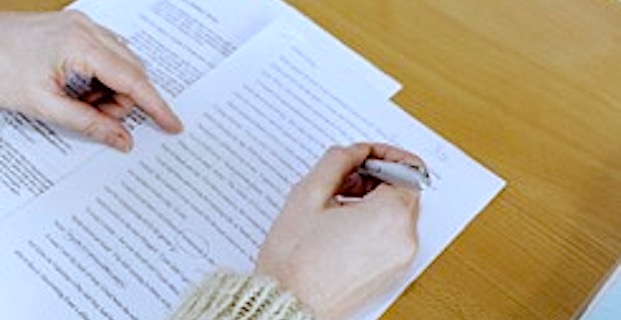by Elle Ray | Aug 21, 2018 | Editing
Get Your Message Right Before You Send It Out
It’s true that the eye often sees what it wants to see, despite evidence to the contrary. Voters read into campaign promises that they’ll end up with a better society if they elect one politician over another. Lonely singles see the perfect mate in a loose collection of bad habits with a pretty face. And writers see a Pulitzer Prize in every word they put on paper.

As it turns out more often than not, none of the above scenarios turn out very well. In fact, when you don’t rely on a second pair of eyes — or detailed scrutiny and background checks — the results can be disastrous.
Who You Gonna Call?
Let’s avoid further pontifications about love and politics. Like religion, they’re topics ripe for meddling or preaching instead of instructing. Rather, we’ll stick to our first-hand knowledge about the importance of editing for clear communication. That’s where our experience lies, after all.
In the past, we’ve written about how to become an editor (see parts one, two and three) and what goes into the secret sauce of editing. But when it comes to the importance of editing for getting your true intentions across to your readers, certain aspects of the art and science cannot be overstated.
You Said What?
In face-to-face communications, how you say something plays a bigger role in messaging than what words you actually use. For example, imagine someone approaching you:
- Shouting in anger: “How long is that going to take?”
- Softly, with a smile: “How long is that going to take?”
While the verbiage is exactly the same, both encounters end up portraying very different meanings. So too can the tone of your writing convey completely different messages. In writing, however, when you don’t have the luxury of bringing your other senses into the conversation, the differences are often more subtle. Consider these variations and how they strike you:
- “Getting a facelift is a big expense.”
- “Getting a facelift is a big investment.”
- “Getting a facelift taps your resources to change your life.”
Each sentence is saying basically the same thing — that it costs a lot of money to get a facelift. But each has a different style. And while you may think this kind of language is just a marketing ploy that you learn in advertising school, think again. You’ve likely seen how punctuation can change a simple call to action: “Let’s eat, Grandma!” or “Let’s eat Grandma!” Make this mistake once and you’ll come to appreciate the importance of editing.
When Edits Matter Most
Maybe you don’t worry about the importance of editing. Perhaps you may believe that your audience understands your intentions. You share your message — on your website, in your blog posts, through employee and customer newsletters, in emails and letters.

But you may not realize how many people lose trust in you — and unsubscribe, delete or even block — when you miss an important mark. Sometimes, mistakes seem minor: an inappropriate exclamation point, a misspelled name or even the wrong verb. Sometimes, mistakes or missteps in tone and style can be so unremarkable that readers don’t even recognize why they’re turned off. But they are.
Accept the Importance of Editing
To reach your business’s audience, you need to accept that a second pair of eyes — preferably professionally-trained eyes like those of Ray Access editors — can help you shape your message so that it’s understood. Editing is more than proofreading. The words you choose matter. And editing makes sure you use the most effective words. Ray Access edits at half price.
Say what you mean and mean what you say. But let your editor check it out before you hit Send, before you click Publish and before you go to press. You’ll be so glad you did. Just like the politician who has to backtrack and the lover who doesn’t show up for the wedding, forgiveness sometimes comes too late. You have to live with the fallout. You’ve not only lost a sale, you’ve actively turned people against you.
What’s the importance of editing? You may as well ask what’s the importance of communication. Why have a website, write blog posts or send newsletters and emails when you aren’t sure you’re getting your message right? Get it right the first time — because that’s often the only chance you get.
Ray Access is a content marketing firm that delivers targeted words to empower your business. Contact us about your specific project to receive a quote or discuss your needs. We write website copy, blog posts, e-newsletters and more. Everything we do is thoroughly researched, professionally edited and guaranteed original.
by Mark Bloom | Feb 20, 2018 | Editing
The Nuts and Bolts, Tips and Tricks of Editing
See Part 1 of this series to understand why editing plays such a vital role in the writing process. Good writing, after all, is basically good editing – even though editors get so little of the glory.
See Part 2 of this series to get a glimpse of the various roles an editor plays in the formation of everything from a blog post to a full-blown novel. Choose one or all of the roles.
How Do You Become an Editor?
Now that you have a number of reasons to become an editor and you know the various levels of editing, it’s time to discuss some of the nitty-gritty details. Like writing, editing is a craft you can learn best by doing.

A few journalism programs still exist in universities around the country, though most don’t have a course of study dedicated to becoming an editor. The best way, and one that most professional editors find works extremely well, is to find a mentor, someone willing to:
- Teach you how to edit
- Coach you for a period of time or through a specific project
- Evaluate your work honestly
- Continue to be available when you have questions or just need one more set of eyes
Getting Down and Dirty
Books on the topic help you learn many of the basics when you want to become an editor. They certainly guide your work, teaching you how to proof content for correct grammar and an appropriate style for the particular piece you’re working on. But there’s nothing like getting your hands dirty with a piece of writing.
Every project you edit is going to be a little different because every writer has different strengths and weaknesses. Some problems you may come up against include:
- Writers who tend to use the same words over and over
- Writers who go off on tangents that don’t support the primary purpose of the project
- Foreign writers who aren’t familiar with connotations, contractions or colloquialisms
- Writers who use too much alliteration
- Writers who fall in love with every word they’ve written
Dealing with Writers
When you become an editor, you work directly with writers. You have to know how to appease them, speak to them and even coddle them. Some writers are easy to work with; they’re eager for advice to make their writing better. Others fight every step of the way.
One approach is to offer suggestions, giving the writer the final say in every decision. For this approach, using Track Changes (in MS Word), Suggestions (in Google docs) or a similar software tool allows you to leave a trail of changes that the writer can follow. The writer, when reviewing the edited work, decides whether to accept each change or not.
This isn’t always easy. You wanted to become an editor to make writing projects better. But just as writers have to let go of their words, sometimes you have to let go of your corrections. Making suggestions instead of hard edits also means more work for you, since you have to justify every major change.
Stating Your Case
Some of your edits are likely to be like no-brainers: poor word choice, incorrect grammar and leaps of logic that seem to come out of the blue. It’s your job to make sure the writer recognizes that your change makes the writing better. You can:
- Leave comments.
- Make notes.
- Be clear about why you made the change or why you requested a revision.
- Suggest ways to fix a problem – providing choices usually gives the writer something to grab onto.
Notes and comments may be the most meaningful, as you can fully explain an issue and provide suggestions for fixing it. You can leave comments no matter what type of technology or tool you use. Even if you’re editing with a red pen, leaving a comment helps you state your case for a change. It is, after all, the reason you chose to become an editor: to educate and ameliorate.
Manipulating Style
When you work with a good writer, most of your edits may come by way of stylistic changes. The most difficult task in writing is connecting with readers – especially in rhetorical writing, where the goal is to persuade readers to consider or take action on a specific topic. The best way to do that is to speak their language.
That’s why editors, like writers, must recognize what drives their intended audience. In this role, you represent the reader; you’re their first and last spokesperson – if you don’t stand up for them, no one else will. This is where editors can really shine. This is where the red pen is mightier than a pair of scissors.
A piece of writing has to be clear, concise and engaging to win over readers. Is it? Does it work? It’s up to you to determine. After all, when you’ve become an editor, you are the expert.
Ray Access is a content marketing firm that delivers targeted words to empower your business. Contact us about your specific project to receive a quote or discuss your needs. We write website copy, blog posts, e-newsletters and more. Everything we do is thoroughly researched, professionally edited and guaranteed original.
by Mark Bloom | Feb 13, 2018 | Editing
Three Ways to Help Writers Hit Their Messages
Read Part 1 of this series, if you haven’t already, to catch up on a few of the reasons it may be difficult to find a direct path to becoming an editor. Part 2 covers the different kinds of talents you need to become an editor. And Part 3 gives you some ways to reach your goals.

To become an editor, you must be able to take a piece of writing that already exists … and make it better. While the purpose of each piece of writing may vary, it doesn’t matter whether it’s a blog post, a newsletter article, a short story or a novel – it’s the editor’s job to make the writer’s work reach its intended audience with the right impact or angle.
There are three ways in which an editor helps the writer succeed. These three levels of editing are based on:
- The writing project’s current stage of writing, per the writer
- The editor’s assessment of the project’s needs
- Ultimately, what the writer and editor agree to focus on
Become an Editor Who Offers Choices
Working with a writer can be a touchy situation. Writers are notoriously attached to their work. They’ve sweated over the details, wracked their brains to find the right words and poured their hearts into the writing. Criticism may even frighten them.
But approach writers with positive energy. You’re not there to destroy; you’re there to improve. Let the writer feel in control. And the best way to do that is to offer choices. Ask for a sample of the work and devise a plan to offer one or more of these three levels of editing:
- Developmental editing
- Copy editing
- Proofreading
Developmental Editing
Developmental editing is a service usually performed near the very beginning of the project. Editors who can offer this service are in the highest demand because it’s a very specific talent. This is when you work with the writer to determine:
- Who’s the intended audience?
- What’s the purpose of the piece?
- What are the most appropriate tone and language to use?
- What’s an appropriate length for the piece?
- What’s the ideal structure for the writing? Should it be written in newspaper style, dramatic style, academic style or something else?
Delve into the answers until you’re satisfied that you share the same goals with the writer. Make sure she understands each point, because the answers to these questions greatly influence the writing. When the first (or second) draft is complete, you’ll be evaluating the writing according to how closely the project hits its goals.

Copy Editing
At this stage, a complete draft of the project already exists. Your job as editor, during the copy-editing phase, is to ensure that the writing flows eloquently and logically from point to point, from sentence to sentence and from section to section. When the writing is good, you have little work to do, but when there are problems, you may have to:
- Question word choices
- Move words, sentences, paragraphs or whole sections around
- Delete words, sentences, paragraphs or whole sections
- Request more information or expanded content in specific areas for specific purposes, which you must identify and convey
The point of this exercise is not to change the writer’s voice necessarily, but to make sure the piece hits its goals as identified in the developmental stage. You also need to make sure it’s easy for the intended audience to read. The danger here is inserting your own voice – intentionally or not – into the writing. You aren’t the author, and the writer has her own style. But the piece has to work.
Proofreading
This level of editing is the least intrusive and the least time-consuming. It involves reading through the piece of writing, only looking for typos, spelling mistakes and grammar errors. You don’t have to be concerned with flow, readability or word choice. It’s simply a final check before the writer can submit the piece, either for publication or approval.
While there are professional proofreaders who do nothing else, to become an editor, you must know how to proofread. And you should offer this service, not because no one else can do it, but because with proofreading, you can offer the full range of editing services.
Become an editor who knows how to do all three levels of editing. Become an editor who knows which service to perform for each piece of writing and who provides the best service to your writing clients. And remember: editing isn’t just about making a particular project as good as it can be; it’s also about making the writer as good as she can be.
Ray Access is a content marketing firm that delivers targeted words to empower your business. Contact us about your specific project to receive a quote or discuss your needs. We write website copy, blog posts, e-newsletters and more. Everything we do is thoroughly researched, professionally edited and guaranteed original.
by Mark Bloom | Feb 5, 2018 | Editing
Going with Your Gut Isn’t a Defensible Strategy
If you want to become an editor, you have to find your own way. There’s no advanced degree program. You won’t find many mentors out there to apprentice with. In fact, depending on who you ask, there apparently isn’t any clear path into the profession.
In addition, there are few jobs with the title. You can become a magazine editor, a newspaper editor or a book editor. You can become an editor who does freelance work, but the pay is as low as the demand.

Yet editors play a vital role in shaping stories, schooling writers and making the world a more comprehensible place. This three-part series delves into the nuts and bolts for people who want to become an editor.
Who Wants to Be an Editor?
So, if demand for editors is low, why become an editor at all? It takes a special breed of person – a cross between a word nerd and a personal trainer. You need to know all the rules, and you have to know when it’s OK to break them. You have to be able to work directly with writers (not the easiest bunch to corral) and lead them to heights even they didn’t realize they could reach.
It’s a myth that editors are failed writers. Many editors are also writers. It’s also a myth that all editors are (or were) English majors when they earned their Bachelor of Arts degrees. What is true is that, to become an editor, you need:
- A Bachelor’s degree in something (not necessarily English), because you need a solid educational foundation
- An ear for language, which is why native speakers make the best editors
- Knowledge of all the grammar rules
- A passion for language, which goes above and beyond grammar rules
- Lots of experience in – and a love of – reading
- A comprehensive vocabulary
The Best Way to Learn Editing
Obviously, experience is the greatest teacher, but what if you have no experience, but still want to become an editor? What do you do then? The short answer is to prepare. Read a lot, especially the types of writing you want to edit. Establish a relationship with a working editor and pick her brains. There are some good books on editing that are worth reading, such as:
- Self-Editing for Fiction Writers by Renni Browne and Dave King
- The Forest for the Trees by Betsy Lerner
- Revising Fiction by Davis Madden
- 100 Ways to Improve Your Writing by Gary Provost
- The Elements of Style by William Strunk and E.B. White
And there are many books on writing that can help you become a better editor, too. Everyone from Ray Bradbury to Stephen King has written books on writing. But don’t forget Writing Fiction by Janet Burroway and Stein on Writing by Sol Stein.
Editing Fiction or Nonfiction
You may notice that many of the recommended titles above focus on writing fiction. While there are some differences between writing and editing fiction vs. nonfiction, there are more similarities than you may realize. That means you can learn a lot about editing nonfiction by learning how to edit fiction.
It all comes down to audience, purpose and approach. There are techniques good editors use to achieve all three, while guiding writers to improve their craft for their next project. And that’s the area where editors resemble coaches: they’re not just concerned with the current project – whether it’s a novel, a magazine article or a blog post – but they also care about writers and helping them improve.
The next installment details the three different kinds of editing that you have to understand if you want to become an editor – and the skills involved with each type. In the meantime, if you need editing, hire the team at Ray Access.
Ray Access is a content marketing firm that delivers targeted words to empower your business. Contact us about your specific project to receive a quote or discuss your needs. We write website copy, blog posts, e-newsletters and more. Everything we do is thoroughly researched, professionally edited and guaranteed original.
by Mark Bloom | Jul 18, 2017 | Editing
Effective Editing Makes Writing Easier to Digest

Editing isn’t a magic wand; it’s a process that involves insight, intelligence and hard work. But before getting to the seven secrets of effective editing, it’s helpful to define the term, so you understand exactly what this article refers to as editing.
The Difference Between Revising and Editing
Effective editing can streamline and refine any piece of writing. Editing takes the author’s intent and sharpens it to better relate to its targeted audience. Revising, on the other hand, requires rewriting the article — which in this case includes blog posts and website content — to better reach its goal. Revising is usually, but not always, done by the author, and it can be an extensive process.
When an article is 90 percent there, editing tightens up the writing and smooths out the wrinkles. When an article is only 50 percent there, it may need more research, more content or even a different approach. In this instance, editing can’t help. It needs to be revised.
The Secrets of Effective Editing
Here are the seven secrets of great editing, as promised. When you work with editors, professional or otherwise, look to see if they deliver results in line with these practices:
- Create concise language. In general, writers hate to cut any words for fear they’ll lose the magic of their prose. Writers love the sound of their own words. Editors don’t suffer from that delusion. Readers’ feelings matter more than writers’ feelings. So — cut to fine-tune the message.
- Choose better words. The right word makes all the difference. Very often, one strong word works much better than a wordy phrase or group of less powerful words. The right word connects better with readers, delivers more of an emotional impact and creates a sense of action. Editing word choices also contributes to Secret #1. So — spend the time to find the right word.
- Develop strong openings. The introduction to any piece of writing should be the last section edited. It needs to feature strong writing that draws in its intended audience, and that can only be done when the editor knows what the article is about. As they say in the newspaper business, “Don’t bury the lede.” So — refine the opening until it sings.
- Let it flow. Every article needs to lead readers from point to point. The writing must flow effortlessly and logically. Sometimes, whole sections need to move up or down to facilitate that flow. Sometimes, sentences fit better elsewhere. So — make sure nothing gets in the way of a good read.
- Break it up. Make sure that the blog post or website page has sufficient subheadings. Almost everyone scans content online. Make it easy for readers with descriptive, short but clever headings that let readers know what’s coming. So — keep every section short, adding headings as needed.
- Double-check the heading text. The title and the headings in any article can spell success or failure. There are whole books written about creating effective titles. Just make sure it’s not clickbait. Instead, create titles and headings that add personality to the piece. And deliver on your promises. So — revise the title and headings as needed to engage readers.
- Read it through a second time. Most editors realize they are the last stop on the road to online publication. The edited article needs to be clear and concise. Effective editing requires a second read-through to catch any typos, omissions or other errors. So — read through the entire article once more before letting it go.
Nothing written is ready for publication until it’s been edited. Effective editing can make the difference between viral and valueless. If you follow all these editing tips in your writing process, you’ll deliver outstanding and effective content to your — or your client’s — website.
The team at Ray Access believes in editing as part of the writing process. Every blog post, website page, press release and newsletter we deliver to a client has been professionally edited. Now you can hire the pros on the Ray Access team to edit your business writing.
by Mark Bloom | Feb 21, 2017 | Editing
And Other Best Editing Practices That Can Help

Every article, blog post or website page — in fact, anything that will appear online — must be edited before it’s published. This seems like a no-brainer, an assertion that’s so obvious that no one would argue against it. But as you likely know, not everyone follows best editing practices. And it’s both unfortunate and so easy to fix.
Any professional writer worth her salt knows that a piece of writing is only as good as the editor behind it. Once you’ve seen your share of typos, misspellings, dangling modifiers, vague pronoun references and creative grammar, you begin to see the light. It’s like one of those “Ah-ha!” moments. You realize that if just one other person had read through the writing before it was published, 90 percent of the problems could have been corrected.
Mistakes Happen
It’s usually best to give your work to another person because a second pair of eyes can catch things in your own writing that you’ll never see for yourself. For example, your eye will fly right over mistakes such as:
- Misspelled names
- Missing words
- Incorrect pronoun use
- Wrong word use
You can find the mistakes you know are there, but it takes another person to see the mistakes you make that you don’t even know you make. You won’t pause to double-check names that look right to you. Your mind will fill in the missing words, so you won’t even notice they’re not really there. And the other errors will seem correct.
Best Editing Practices That Are Easy
Editing doesn’t have to be a difficult, expensive or drawn-out process. While a professional editor should review anything that involves your business, you don’t need to hire one for your personal blog. But you should learn some common editing tips so you too can get closer to best editing practices. Easy editing techniques include:
- Sleeping on it. This little tip really works, especially if you’re a good writer. Basically, after you’ve finished the first draft — and that means finished it completely — put it aside and don’t even look at it. Return to it the next day, when you’re refreshed but it’s not so fresh in your mind, and reread your words, checking to see if it’s as wonderful as you remember. Be objective and make the changes you need to make to improve the article. You will find lots of mistakes and things to change.
- Read it out loud. This tactic is common among novelists and screenwriters, but it can work for your online content, too. It’s one of those best editing practices that seems too easy, but simply by reading something out loud, to yourself or to another person, highlights obvious errors that you’d otherwise miss. Your eye’s trained to read just what’s on the page so the absence of words jumps out at you.
- Read it backward. If you’re sure what you wrote is bullet-proof, read it backward. You’ll find misspellings, and odd word choices that you’ll feel compelled to change. You won’t catch any grammar mistakes doing this exercise, but you’ll be amazed at what you do find. This may become your standard practice.
Ray Access is a content marketing firm that delivers targeted words to empower your business. Contact us about your specific project to receive a quote or discuss your needs. We write website copy, blog posts, e-newsletters and more. Everything we do is thoroughly researched, professionally edited and guaranteed original.








